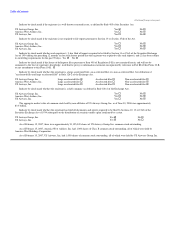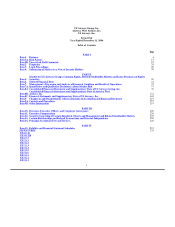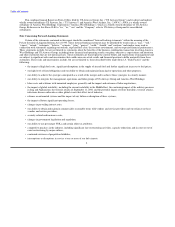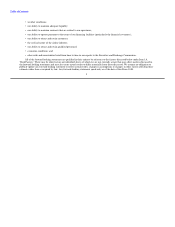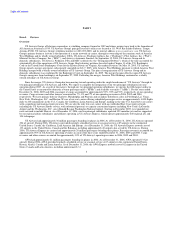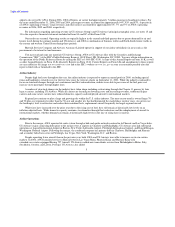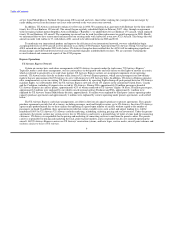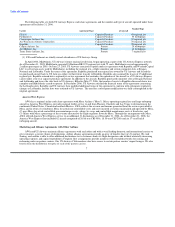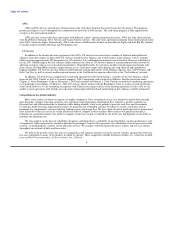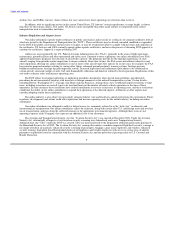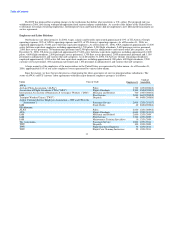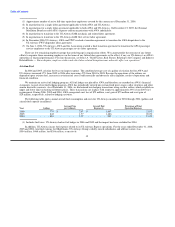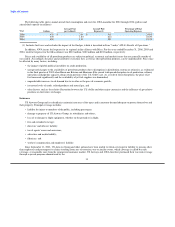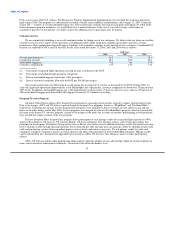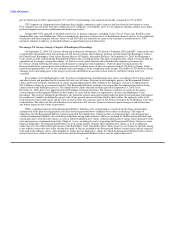US Airways 2006 Annual Report Download - page 13
Download and view the complete annual report
Please find page 13 of the 2006 US Airways annual report below. You can navigate through the pages in the report by either clicking on the pages listed below, or by using the keyword search tool below to find specific information within the annual report.
Table of Contents
Funding for TSA is provided by a combination of air-carrier fees, passenger fees, and taxpayer monies. The air-carrier fee, or
Aviation Security Infrastructure Fee ("ASIF"), has an annual cap equivalent to the amount that an individual air carrier paid in calendar
year 2000 for the screening of passengers and property. TSA may lift this cap at any time and set a new higher fee for air carriers. In
2005, TSA assessed additional ASIF liability on 43 air carriers, including AWA, US Airways, Piedmont, PSA and non-owned affiliates
for whom AWA and US Airways pay ASIF. The passenger fee, which is collected by air carriers from their passengers, is currently set at
$2.50 per flight segment but not more than $10.00 per round trip.
In 2006, we incurred expenses of $56 million for the ASIF, including amounts related to regional carriers. US Airways incurred
expenses of $44 million including amounts paid by US Airways Group's wholly owned regional subsidiaries. AWA incurred expenses of
$12 million including amounts related to regional carriers. Our expenses will further increase for amounts assessed to non-owned
regional affiliates who can pass through their increased ASIF to US Airways. Implementation of the requirements of the Aviation
Security Act have resulted and will continue to result in increased costs for us and our passengers and has and will likely continue to
result in service disruptions and delays. As a result of competitive pressure, AWA, US Airways and other airlines may be unable to
recover all of these additional security costs from passengers through increased fares. In addition, we cannot forecast what new security
and safety requirements may be imposed in the future or the costs or financial impact of complying with any such requirements.
Most major U.S. airports impose passenger facility charges. The ability of airlines to contest increases in these charges is restricted
by federal legislation, DOT regulations and judicial decisions. With certain exceptions, air carriers pass these charges on to passengers.
However, our ability to pass through passenger facility charges to our customers is subject to various factors, including market conditions
and competitive factors.
At John F. Kennedy International Airport, LaGuardia and Reagan National, which are designated "High Density Airports" by the
FAA, there are restrictions that limit the number of departure and arrival slots available to air carriers during peak hours. In April 2000,
legislation was enacted that eliminated slot restrictions in January 2007 at LaGuardia and Kennedy. On December 20, 2006, the FAA
implemented an interim rule to maintain the number of hourly operations at LaGuardia until a final rule is adopted. The FAA proposed a
comprehensive final rule for LaGuardia in August 2006. The proposed rule would require a minimum number of seats on all operations
to/from LaGuardia except for those expressly exempted. Failure to comply with the average seat per departure requirement would lead to
the withdrawal of operating authority until compliance is achieved. The proposed rule also introduces a finite lifespan for "operating
authorizations" of no more than ten years. The FAA intends to seek Congressional approval for the introduction of market based
mechanisms for allocating expiring operating authorizations. We have filed extensive comments with the FAA in December 2006
detailing the numerous concerns we have with the proposed rule. Given the need for Congressional legislation to implement a portion of
the proposed rule, we do not believe final action on a new rule is likely before late 2007 at the earliest.
In the future, takeoff and landing time restrictions and other restrictions on the use of various airports and their facilities may result
in further curtailment of services by, and increased operating costs for, individual airlines, including our airline subsidiaries, particularly
in light of the increase in the number of airlines operating at these airports. In general, FAA rules relating to allocated slots at High
Density Airports contain provisions requiring the relinquishment of slots for non-use and permit carriers, under certain circumstances, to
sell, lease or trade their slots to other carriers. Each slot must be used on at least 80% of the dates during each two-month reporting
period. Failure to satisfy the use rate will result in loss of the slot and reversion of the slot to the FAA for reassignment through a lottery
arrangement. As of December 31, 2006, US Airways and AWA exceeded the minimum use rate.
Where the FAA has seen congestion and delay increases, it has generally stepped in and worked with the carriers to freeze
operations at current or somewhat reduced levels. Specifically, incumbent carriers, including US Airways and AWA, are not permitted to
increase operations at Chicago O'Hare International Airport as a result of an agreement reached between the FAA and these airlines in
August 2004. A final rule memorializing many of the terms of the August 2004 agreement was released in August 2006.
The availability of international routes to domestic air carriers is regulated by agreements between the U.S. and foreign
governments. Changes in U.S. or foreign government aviation policy could result in the alteration or termination of these agreements and
affect our international operations.
10


